Spider Green Marble originates from Rajasthan, India—the nation’s premier marble-producing state responsible for the majority of India’s quality marble extraction. This natural stone forms through metamorphic processes where limestone undergoes significant heat and pressure transformations, developing the characteristic crystalline structure and polishability that distinguish marble from its sedimentary limestone precursor.
The stone’s distinctive name derives from its unique web-like white veining patterns against a rich green background, creating visual effects reminiscent of spider webs or intricate natural fractals. Each slab exhibits completely unique veining patterns—no two pieces are identical—ensuring every installation becomes a one-of-a-kind artistic statement. This inherent uniqueness appeals strongly to designers and architects seeking materials that cannot be replicated.
The green coloration results from mineral impurities present during the limestone’s metamorphosis, typically including serpentine, chlorite, or other iron and magnesium-bearing minerals. Color intensity varies from light jade to deep bottle green depending on mineral concentration and quarry location within Rajasthan. The white veining represents calcite or dolomite mineral concentrations that create the dramatic contrast defining this marble variety.
Buyers specify Spider Green for luxury residential interiors seeking statement materials, commercial lobby flooring where visual impact matters, feature walls in hotels and restaurants, custom countertops in high-end kitchens, bathroom vanities and shower surrounds, outdoor landscaping features when properly sealed, fireplace surrounds as focal points, monuments and memorials requiring distinctive green tones, and decorative mosaics showcasing the stone’s intricate patterns. The bold green palette coordinates with both contemporary and traditional design styles, particularly when paired with neutral whites, blacks, or natural wood tones.
Performance and Quality
Spider Green Marble demonstrates performance characteristics typical of calcite marbles with some unique considerations. The material is classified as relatively soft compared to other marble varieties and significantly softer than granite. This softness necessitates special handling during fabrication and installation—manufacturers routinely apply fiber mesh netting to the slab backside to ensure structural stability and prevent cracking during transport, installation, and use.
The stone exhibits good durability when properly maintained, with documented minimum lifespans exceeding 15 years in residential applications. Commercial high-traffic installations show acceptable wear patterns when appropriate maintenance protocols are followed. However, marble’s inherent susceptibility to scratching, chipping, and staining requires realistic expectations about performance compared to harder stones like granite.
Heat resistance is moderate; the stone withstands normal household temperatures but can be damaged by extreme heat or thermal shock. Users must always employ trivets or hot pads for cookware and avoid placing items directly from ovens or stovetops onto marble surfaces. Acidic substances pose significant risk—citrus juices, vinegar, wine, and acidic cleaners can etch the polished surface, creating dull spots that require professional restoration.
The stone’s susceptibility to staining demands prompt attention to spills, particularly from coffee, tea, oils, and pigmented liquids. Without proper sealing maintenance, porous marble absorbs liquids that can cause permanent discoloration. Regular sealing creates a protective barrier that significantly improves stain resistance, though it does not make the stone completely impervious.
Despite these considerations, Spider Green’s striking visual impact and natural elegance create design value that justifies the additional maintenance requirements for buyers prioritizing aesthetics. The high polish achievable on marble surfaces—superior to most other natural stones—produces light-reflective qualities that enhance spatial brightness and create luxurious ambiance.
Materials and Construction
Spider Green undergoes specialized processing due to its relative softness and natural fissuring patterns. After quarrying, blocks are cut into slabs using diamond-wire saws or gang saws. During initial processing, numerous light green or white cracks visible in the dark green background receive treatment—fabricators fill natural fissures and micro-cracks with polyester resin before the polishing step. This resin filling is standard industry practice for marble, providing structural reinforcement and creating the smooth surface consumers expect.
Following resin treatment, fiber mesh netting is adhered to the slab backside using epoxy adhesives. This fiber net backing provides critical tensile strength that the relatively soft marble lacks naturally, preventing slab breakage during handling, transport, and installation. The backing remains invisible once installed and does not affect the stone’s appearance or performance.
Book-matching techniques create mirror-image patterns when slabs from the same block are cut consecutively and placed side-by-side. This specialized cutting and arrangement ensures pattern flow continuity across large installations, particularly valuable for feature walls where visual continuity matters. Book-matched Spider Green creates dramatic symmetrical designs that emphasize the stone’s natural artistry.
The polishing process progresses through multiple grinding and buffing stages, removing approximately 1mm from the tile face to achieve the characteristic glossy sheen. This high-polish finish clarifies the stone’s coloring, brightening white veins and creating magnificent contrast against the rich green background. The polished finish also provides practical benefits—smooth surfaces resist dirt accumulation and simplify cleaning compared to textured finishes.
Parameter |
Description |
| Slab Sizes | Gangsaw slab 280 x 180 CM up in 2, 3 CM, and other |
| Tiles | 30×30, 30×60, 40×40, 60×40, 60×60, 60 x 90, 60×120 CM in various thicknesses and custom sizes |
| Thickness | 20mm, 30mm, 40mm, 50mm and more thickness we cut on clients demand. |
| Finishes | Polished, Honed, Leather, Brushed, and Sandblasted |
| Application | Counter/Vanity Top, Flooring, Cladding, Marble Handicrafts, Swimming Pool Areas, Bathroom Walls & Floors, Fireplace Walls, External & Internal Aids In Construction |
| Place of Origin | North India |
Maintenance and Care
Spider Green Marble requires attentive maintenance to preserve appearance and performance. Apply quality penetrating sealer every 1-2 years minimum; annual sealing is recommended for high-use areas like kitchen countertops and commercial flooring. Test sealer effectiveness annually by placing water droplets on the surface—if water absorbs within 10 minutes rather than beading, immediate resealing is necessary.
Daily cleaning requires only mild soap or pH-neutral cleaner mixed with warm water, applied with soft cloth or microfiber mop. Never use harsh chemicals, abrasive cleaners, or acidic substances including vinegar, lemon juice, ammonia, or bleach. These products damage marble surfaces, etching the polish or removing sealer protection. Avoid abrasive scrubbers or brushes that scratch the polished finish.
Address spills immediately—particularly coffee, tea, wine, fruit juices, oils, and colored liquids. Blot spills with clean cloth rather than wiping, which can spread the liquid across a larger area. For dried stains, create a poultice using baking soda and water paste, apply to stain, cover with plastic wrap for 24 hours, then remove and rinse. Stubborn stains may require professional restoration services.
For countertops, always use cutting boards for food preparation—knife scratches permanently damage polished surfaces. Use coasters under glasses and bottles to prevent water rings and etching from acidic beverages. Place protective pads under decorative items that might scratch or stain the surface.
For flooring installations, establish routine of daily dust mopping to remove grit and debris that can scratch the surface when walked upon. Weekly damp mopping with neutral cleaner maintains appearance. Place walk-off mats at entrances to trap dirt and moisture before they reach marble floors. Avoid dragging furniture across marble surfaces—lift items or use furniture pads.
Expected service life ranges from 15 to 40+ years for interior applications with proper maintenance. Outdoor installations require more intensive care including quarterly cleaning and annual resealing due to weather exposure, with expected lifespan of 10-25 years depending on climate conditions and maintenance diligence.
Installation and Compatibility
Professional installation by experienced stone fabricators familiar with marble is essential due to Spider Green’s softness and special handling requirements. The fiber net backing and resin-filled fissures demand careful cutting techniques—fabricators must use sharp diamond blades and slow cutting speeds to prevent chipping, cracking, or delamination of the fiber backing during fabrication.
For countertop installations, fabricators create precise templates, cut slabs to specification while supporting the fiber-backed material properly, polish edges to desired profile, and install using marble-compatible adhesives that bond to both stone and fiber backing. Installation typically requires 2-4 days for standard residential configurations, longer than granite due to the material’s delicate nature requiring extra care.
For flooring, use modified thin-set mortar specifically rated for marble over properly prepared, level substrate. Ensure substrate can support the weight (approximately 8-10 lbs per square foot for 2cm thickness). Floor deflection must not exceed industry standards—excessive flex can crack marble tiles. Use unsanded grout to avoid scratching polished edges during grouting.
Grout color selection significantly affects final appearance. Light grey, cream, or soft white grout harmonizes with the stone’s white veining, creating seamless elegant appearance. Contrasting dark grout emphasizes individual tiles for geometric pattern emphasis but may show dirt more readily.
For outdoor applications, the stone requires proper sealing before installation and establishment of rigorous maintenance schedule. Avoid installation in areas subject to freeze-thaw cycles unless using specialized sealers and accepting potentially shortened lifespan. Cover outdoor surfaces during harsh weather when possible to protect sealer and minimize weathering.
Pros & Cons
Advantages
- Unique visual impact: Distinctive spider-web veining pattern ensures no two slabs match; creates one-of-a-kind installations impossible to replicate
- High polish achievable: Marble’s crystalline structure takes superior polish compared to granite, creating light-reflective luxury appearance
- Versatile design compatibility: Rich green palette coordinates with contemporary, traditional, and eclectic styles; pairs well with neutrals
- Natural stone authenticity: Real marble provides prestige and timeless elegance synthetic materials cannot match
Considerations
- Requires diligent maintenance: Annual sealing mandatory; immediate spill cleanup essential; more maintenance than granite or quartz
- Softer than granite: Susceptible to scratching, chipping, and etching from acids; cutting boards and trivets non-negotiable
- Limited supplier availability: Complex processing requirements (fiber backing, resin filling) mean fewer suppliers despite high demand; longer lead times possible
Who Should Buy
Ideal Buyers
- Luxury residential renovators seeking distinctive, nature-inspired statement materials that create conversation-worthy focal points
- Boutique hospitality designers requiring unique natural stone for lobby feature walls, restaurant interiors, or spa environments
- High-end kitchen designers whose clients prioritize aesthetics over maintenance convenience and appreciate natural stone authenticity
- Nature enthusiasts drawn to green tones and organic patterns who commit to proper maintenance protocols
- Commercial designers specifying decorative wall cladding where visual impact matters more than high-traffic durability
Not Recommended For
- Budget-conscious projects where cost is primary concern over aesthetics (consider standard beige or white marbles)
- Busy households unwilling to maintain annual sealing schedule or clean spills immediately
- High-traffic commercial flooring requiring maximum durability (consider granite or porcelain instead)
- Outdoor applications in freeze-thaw climates or harsh coastal environments
- DIY installers without professional stone fabrication experience—fiber-backed material requires specialized handling
FAQs
Q1: Why does Spider Green Marble require fiber net backing when other marbles don’t?
Spider Green is relatively soft compared to other marble varieties and contains numerous natural light-colored cracks that create its characteristic spider-web appearance. These natural fissures require resin filling for stability, and the fiber mesh backing provides additional tensile strength to prevent breakage during handling and installation. This is standard processing for this specific marble variety.
Q2: Can Spider Green Marble be used for outdoor patios in cold climates?
Outdoor use is possible when properly sealed, but not recommended for freeze-thaw climates. Marble is porous and absorbs water; when that water freezes and expands, it can crack the stone. Spider Green is better suited for indoor applications or outdoor use in warm climates without freezing temperatures. If used outdoors, establish quarterly sealing schedule and cover during harsh weather.
Q3: How do I remove etching caused by acidic spills on Spider Green Marble?
Etching (dull spots from acid damage) requires professional restoration. DIY attempts with marble polishing powder may improve minor etching but cannot fully restore factory polish. Prevention is essential—immediately wipe acidic spills (citrus, vinegar, wine, tomato) and never use acidic cleaners on marble. For significant etching, contact professional stone restoration services.
Q4: Is Spider Green Marble suitable for high-traffic commercial flooring?
Spider Green works for moderate-traffic commercial spaces like office lobbies or boutique retail when properly maintained. However, it is not ideal for high-traffic areas like shopping mall corridors or restaurant kitchens due to marble’s susceptibility to scratching and wear. The stone is described as suitable for “rigid wearing” in high-traffic home areas but requires realistic expectations for commercial intensity.
Q5: Why is Spider Green Marble more expensive than other green marbles from India?
Spider Green is considered premium-quality and rare due to its distinctive appearance, high market demand, and complex processing requirements. The mandatory resin filling and fiber backing application add processing costs and time. Additionally, few suppliers have the technical capability to process this stone properly, creating supply constraints that support premium pricing despite quarry availability.
Q6: Can Spider Green Marble be book-matched for feature walls?
Yes, Spider Green can be book-matched by cutting consecutive slabs from the same block and arranging them to create mirror-image patterns. This technique is particularly popular for feature walls in dining rooms, living rooms, and bathrooms where the symmetrical pattern creates dramatic visual impact. Specify book-matching requirements when ordering to ensure fabricator selects appropriate sequential slabs.

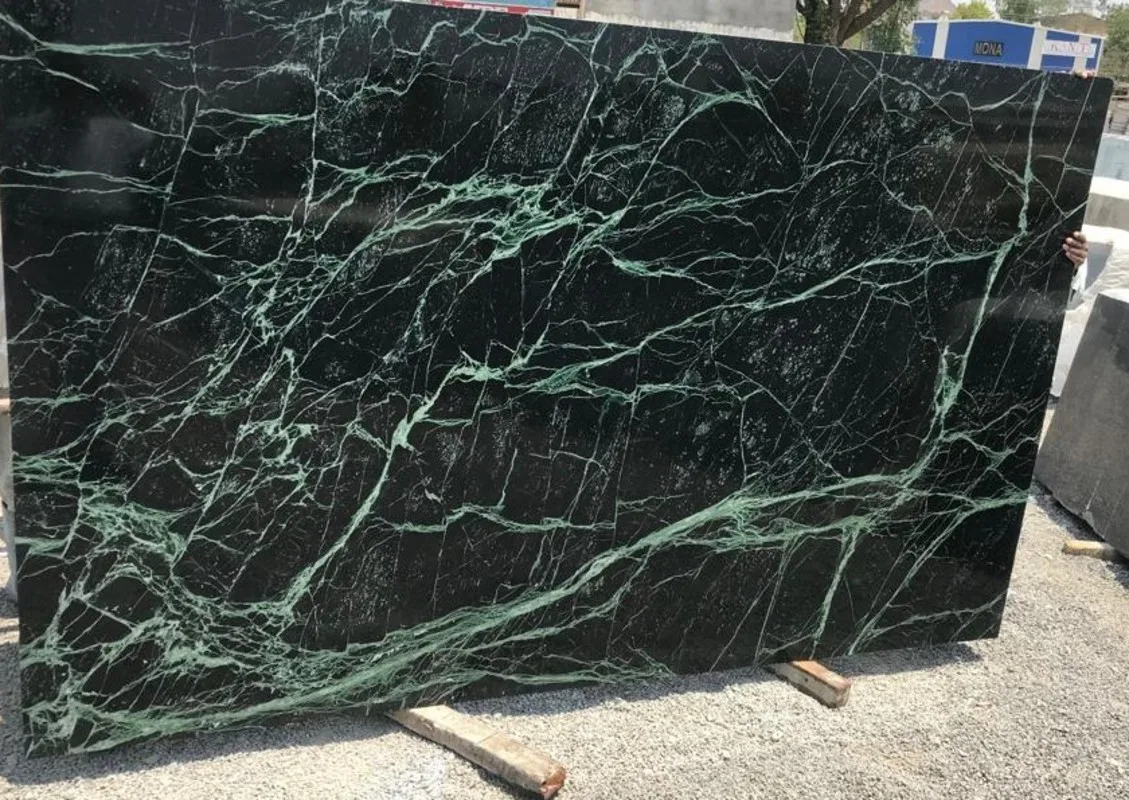
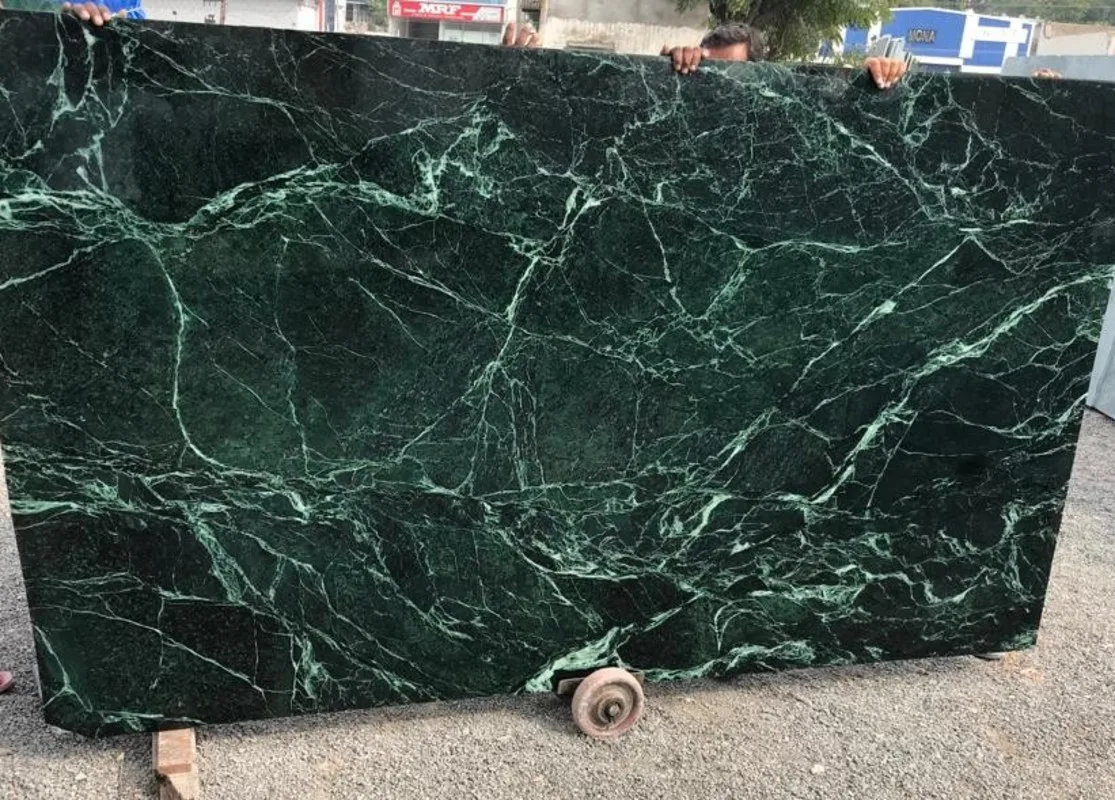
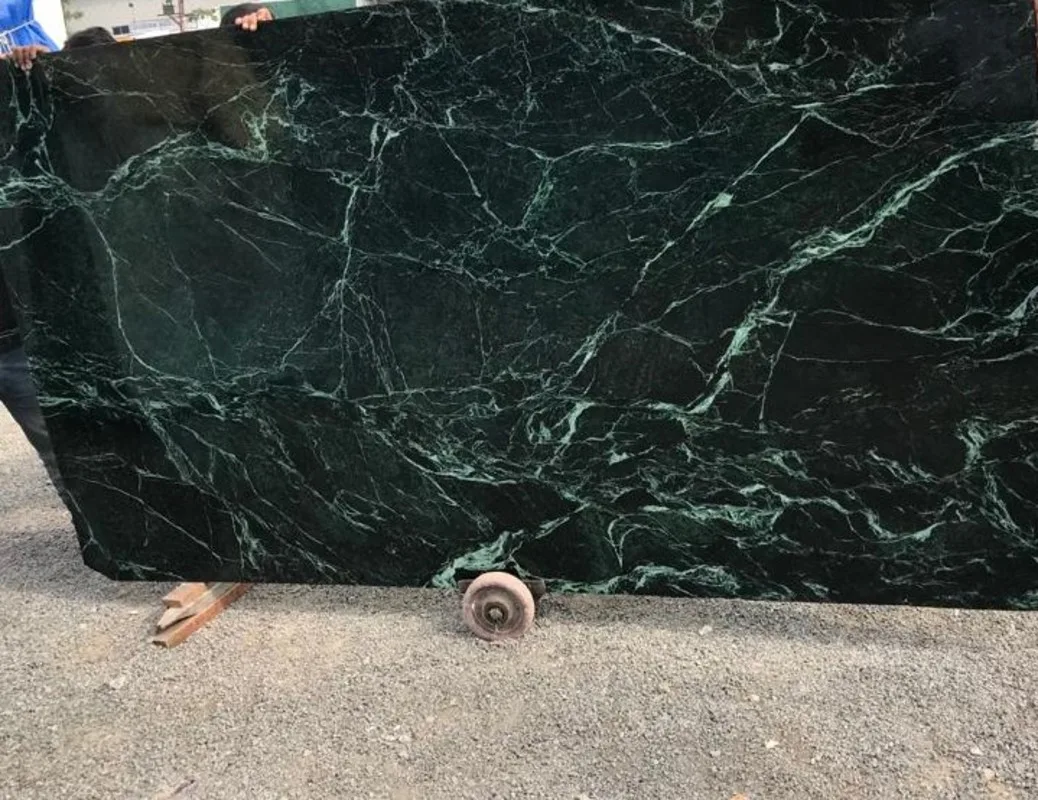
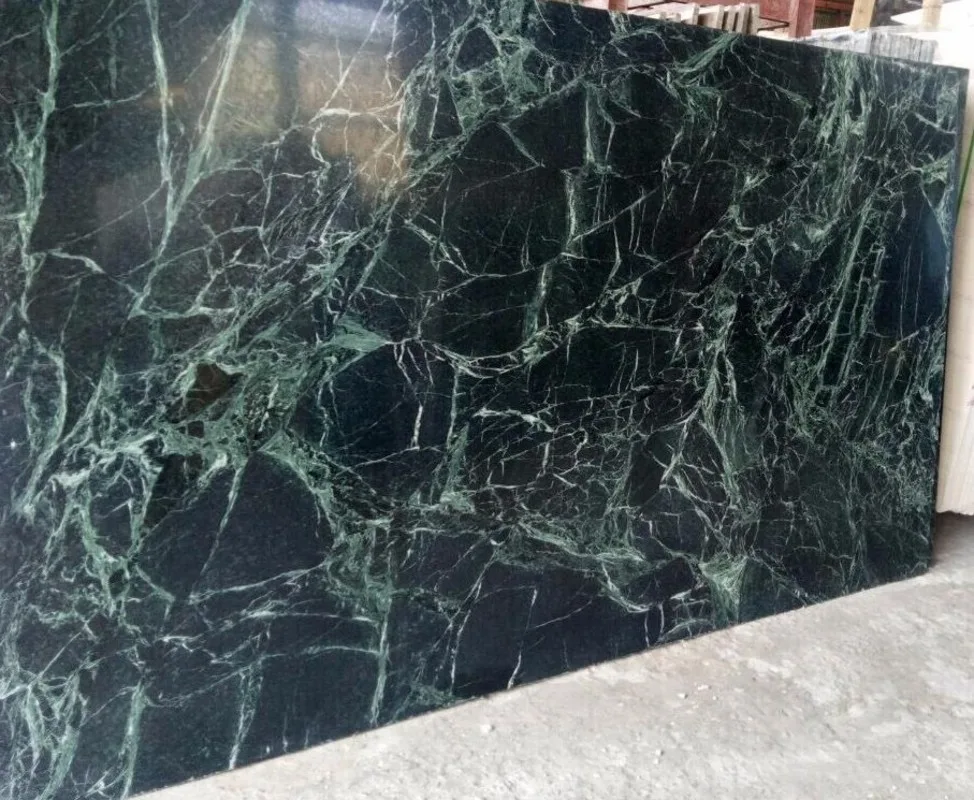
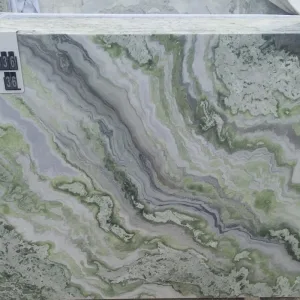
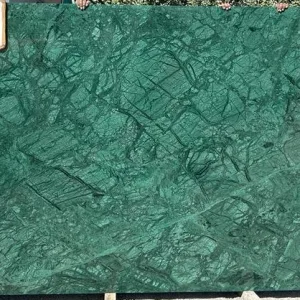
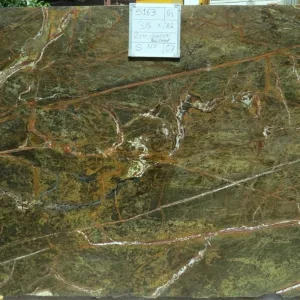
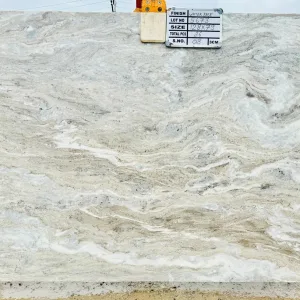
Reviews
There are no reviews yet.